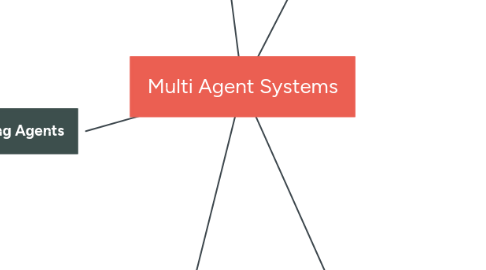
1. Deductive Reasoning Agents
1.1. Agent-Oriented Programming
1.1.1. AGENT0 (Shoham)
1.1.1.1. Not "pure" logical rules
1.1.1.2. Initial beliefs
1.1.1.3. Commitment rules
1.1.1.4. Communicative actions
1.1.1.4.1. Inform
1.1.1.4.2. Request
1.1.2. PLACA (Thomas)
1.1.2.1. Mental change rules
1.2. Concurrent MetateM(Fisher)
1.2.1. Temporal logic programming
1.2.2. "pure" logical rules
1.2.3. Past => Future rule
1.2.4. Execution = constructive proof of satisfiability
1.3. Two key problems
1.3.1. Transduction
1.3.2. Representation/Reasoning
1.4. Agents as theorem provers
1.4.1. State of agent is set of logical formulae (beliefs)
1.4.2. Decision-making program is logical theory (typically rules)
1.4.3. Disavantages
1.4.3.1. Calculative rationality
1.4.3.2. Complexity of reasoning
1.4.4. Advantages
1.4.4.1. Clear logical semantics
1.4.4.2. Transparency
1.5. Key Idea: Decision-making/action selection via logical reasoning
2. Practical Reasoning Agents
2.1. Commitment
2.1.1. To ends (to intentions)
2.1.2. To means (to plans)
2.1.3. Commitment strategies
2.1.3.1. Blind commitment
2.1.3.2. Single-minded commitment
2.1.3.3. Open-minded commitment
2.1.4. Reconsideration
2.1.4.1. Frequently reconsider in dynamic environments
2.1.4.2. Infrequent reconsideration in static environments
2.2. Procedural Reasoning System (PRS)
2.2.1. Operationalize intentions via plans
2.2.2. Plans invoked by event/context
2.2.3. PRS plans composed of
2.2.3.1. Goal - what will be achieved
2.2.3.2. Context - preconditions
2.2.3.3. Body - the "recipe"
2.3. Key Idea: Action selection through means-ends reasoning and deliberation
2.4. Practical reasoning composed of
2.4.1. Means-end reasoning
2.4.1.1. Planning
2.4.1.2. How do I achieve my goal?
2.4.1.3. Inputs are goals, beliefs, actions
2.4.1.4. STRIPS-style action representation (pre and postcondition)
2.4.1.4.1. Precondition
2.4.1.4.2. Delete list
2.4.1.4.3. Add list
2.4.2. Deliberation: Selecting intentions
2.4.2.1. Considering options
2.4.2.2. Filtering options to choose intentions
2.5. Intentions
2.5.1. Pro-attitudes (stronger than desires)
2.5.2. Drive means-ends reasoning
2.5.3. Persist over tie (commitment)
2.5.4. Constrain future deliberation
3. Reactive and Hybrid Agents
4. Introduction
4.1. Five Trends
4.1.1. Ubiquity
4.1.1.1. Moore's Law
4.1.1.2. Embedded systems
4.1.2. Interconnection
4.1.2.1. The Internet
4.1.2.2. Mobile Computing
4.1.3. Intelligence
4.1.3.1. not just AI
4.1.3.2. Information processing
4.1.4. Delegation
4.1.5. Human-Orientation
4.1.5.1. Move away from machine abstractions to human abstractions
4.2. Why Multi agent Systems?
4.2.1. Agents for Software engineering
4.2.1.1. The Grid
4.2.1.2. The semantic Web
4.2.1.3. Ubiquitous computing
4.2.2. Agents for understanding human societies
4.2.3. Agents for distributed economic systems
4.3. Two Problems
4.3.1. Micro-issues: how to build an agent
4.3.2. Macro-issues: How to put agents together
4.4. Objections
4.4.1. Isn't it just distributed systems?
4.4.1.1. Distributed systems don't take account of preferences
4.4.2. Isn't it just AI?
4.4.2.1. AI traditionally focused on agent capabilities
4.4.3. Isn't it just economics?
4.4.3.1. Economic solutions take no account of computation
4.4.3.2. A new type of economic system
4.4.4. Isn't it all just social sciences?
4.4.4.1. We focus on computational agents
5. Intelligent Agents
5.1. Intelligent agent
5.1.1. Reactive
5.1.2. Proactive
5.1.3. Social
5.2. Agents and Objects
5.2.1. Agents have autonomy
5.2.2. Agents have goals
5.3. Agents and Expert Systems
5.3.1. Agents act
5.3.2. Expert systems are disembodied
5.4. Agents as intentional systems
5.4.1. "mental states"
5.4.2. Information attitudes
5.4.3. Pro-attitudes
5.5. Optimal action
5.5.1. Maximize expected utility
5.5.2. Bounded Optimality
5.6. How to tell an agent what to do
5.6.1. Utility functions over states
5.6.1.1. Where do the numbers come from?
5.6.2. Utility functions over runs
5.6.2.1. Predicate task specifications: Goals
5.6.2.1.1. Achievement tasks/goals
5.6.2.1.2. Maintenance tasks/goals
5.7. Environments
5.7.1. Accessible/Inaccessible
5.7.2. Static or Dynamic
5.7.3. Discrete or continuous
5.7.4. Action
5.7.4.1. Deterministic
5.7.4.2. Non-deterministic
5.7.4.3. Provide information
